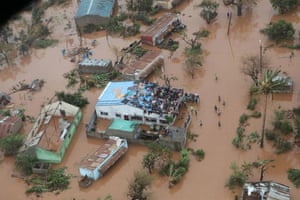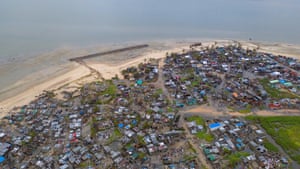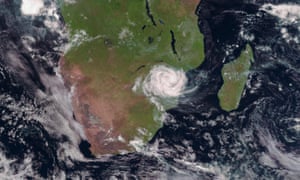
The devastating cyclone that hit south-eastern Africa may be the worst ever disaster to strike the southern hemisphere, according to the UN.
Cyclone Idai has swept through Mozambique, Malawi and Zimbabwe over the past few days, destroying almost everything in its path, causing devastating floods, killing and injuring thousands of people and ruining crops. More than 2.6 million people could be affected across the three countries, and the port city of Beira, which was hit on Friday and is home to 500,000 people, is now an “island in the ocean”, almost completely cut off.
The official death tolls in Mozambique, Zimbabwe and Malawi are 200, 98 and 56 respectively. But these totals only scratch the surface; the real toll may not be known for many months as the countries deal with a still unfolding disaster.
Mozambique’s president, Filipe Nyusi, announced three days of national mourning late on Tuesday and said his government would declare a national emergency.
The country has been hit by cyclones and floods before. The most devastating in recent memory were in 2000, but these could be even worse.
Houses, roads and telegraph poles are completely submerged. The Mozambican and South African military and other organisations are working to rescue people from the air, though many are struggling to get supplies and teams to the region because roads and bridges have been ripped up or have huge sinkholes in them.
Some people are stranded clinging to trees; others are on houses or “new islands” that have formed, and have no food, according to rescue workers.
“Sometimes we can only save two out of five; sometimes we rather drop food and go to someone else who’s in bigger danger,” Ian Scher from Rescue SA told AFP. “We just save what we can save and the others will perish.”
A pilot doing a survey for Mission Aviation Fellowship flew over the basin of Buzi river in Mozambique, which had burst its banks, and was able to provide the first information on the area.
“It was a heartbreaking flight today as we flew over many miles of flooded land in the Buzi River basin. We saw many people stranded on roof tops surrounded by kilometres of water. It was difficult to comprehend and think about that probably many have perished,” Rick Emenaker told the South African site Lowvelder.

With the first flight leaving on Sunday and one mobile network, Movitel, just restored, more details are beginning to emerge of what happened in Beira when the cyclone hit.
“It is a total mess here. Please pray for the thousands and thousands who have lost their homes,” said Jill Lovell, an Australian who runs a mission school in Beira, in an emailed message. “People are in trees and on rooftops. Emergency relief crews are slowly coming in. Rains continue to make it all even harder. So many lives lost and homes destroyed.”

The Red Cross managed to get one truck containing chlorine tablets and 1,500 tarpaulins and tools to make shelters into Beira before it was cut off. Another was diverted to Manica, while the Red Cross is also trying to bring in more supplies from the island of Réunion by boat. The World Food Programme managed to get food supplies in and is doing airdrops to stranded people.
“Where there was land, there’s now sea. The city itself is completely cut off. It’s really an island now in the ocean,” said Matthew Cochrane of the Red Cross, adding that an emergency appeal would be launched to raise an initial 10m Swiss francs to provide mostly shelter and clean water.
Health is a major worry and the risk of outbreaks of cholera and typhoid is high, especially as there are reports that water pipelines to the city have been cut.
Mark Ellul, a British doctor who was in Beira when the cyclone hit, said conditions at the central hospital, next to the sea in the middle of the city, had already been bad and it had been operating at full capacity when the storm hit. He heard that patients had been in the wards when Idai struck, ripping off part of the roof and destroying what windows were left.
“The ones that could walk tried to get out of there and get into the corridors and the ones who couldn’t walk just kind of held on to their beds,” he said.
Ellul pulled out the plumbing and barricaded himself under the sink in his hotel room during the cyclone. When he came out, he saw debris thrown everywhere, trees ripped up, roofs ripped off and electricity poles pushed over the roads. He said met many people who said they had seen bodies in the street or whose neighbours had been killed.
Residents of Beira said there were reports of dams 70km from the city bursting, possibly Chicamba dam above Chimoio, north-west of Beira, or perhaps the Mavuzi dam, a smaller reservoir. Other dams are thought to be full to the brim and will have to open their floodgates soon. The colossal Kariba and Cahora Bassa dams on the Zambezi river are not thought to be under threat, but both were built about 50 years ago and the Kariba needs urgent maintenance.
The Red Cross has started a list of people registered as alive, or missing, which family members can search or add to.


